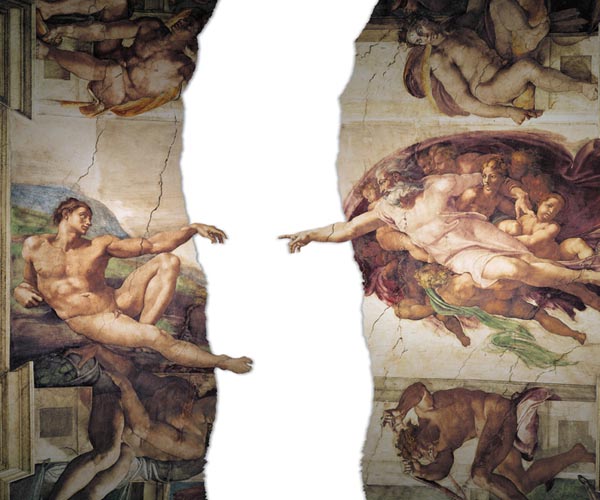
Ever since Rashomon took the grand prize at the Venice Film Festival 50 years ago, the movie by Japanese director Akira Kurosawa has been the subject of extensive critical analysis. Based loosely on two early-20th-century short stories, one of which was itself a retelling of several tenth-century Japanese narratives, the film relates the story of an encounter in the woods from the varying perspectives of four participants: a woodcutter, a patrician, the patrician’s beautiful wife and a bandit.1 As each narrator speaks, his or her version of events is depicted on screen. The woodcutter’s account is simple and unsophisticated; the bandit’s is jumpy and jittery; the patrician’s is dignified and the damsel’s is hysterical. Depending on the version, the film viewer witnesses a scenario that involves either a murder or a suicide, preceded by a rape or a seduction. The four stories—both overlapping and contradictory—leave the viewer hard-pressed to sort out the truth about what happened in the woods.
Rashomon was instantly recognized as a complete departure from contemporary conventions of cinematography and narrative technique. Critics deliberated the philosophical and moral implications of the film. But director Kurosawa, impatient with what he considered overanalysis, wanted his movie to be regarded merely as a good mystery story.2
No matter how annoyed he may have been with the dissection of his film, however, Kurosawa probably should have considered himself lucky: at least he did not have to contend with advocates of the documentary hypothesis of biblical scholarship. If critics had applied the criteria of the documentary hypothesis to Rashomon, it is likely that the film would have been ascribed not to one director, Akira Kurosawa, but to at least four different directors, each with a different artistic style. Moreover, Kurosawa’s reliance on earlier stories, some written centuries ago, might have led some source critics to conclude that Rashomon was not an original work of art at all but merely a compilation, and that Kurosawa was at best the editor, or, to use the preferred academic term, the redactor, of these popular fictions.
The documentary hypothesis propounded by Bible scholars teaches that the five books traditionally attributed to Moses are a patchwork, gathered from the writings of four principal authors or schools of authors—called J, E, P and D—whose work was stitched together by a final redactor, known as R. The J source is identified by its use of “YHWH” (German, JHWH; vocalized as “Yahweh” and often rendered in English translations as “Lord”), which Jews consider to be the sacred, unpronounceable, personal name of God, used throughout the Hebrew Bible to signify the one God of the covenant and the universe. The E source is so named because it refers to God as “Elohim”—a generic term used to refer to pagan gods as well as to the God of Israel. P is concerned with priestly matters such as laws, dates and genealogies, and D is thought to be responsible for the core of the Book of Deuteronomy.
Advocates of the documentary hypothesis see different hands at work in the very first chapters of Scripture, where we find two apparently conflicting accounts of the origins of life: Genesis 1:1–2:4a, which details the seven days of Creation, beginning with light and concluding with animals, human beings and the Sabbath; and Genesis 2:4b–24, in which God first makes Adam and then forms the animals and a woman as company for the man (see the sidebar to this article). According to the documentary hypothesis, chapter one of the Book of Genesis derives from P and offers the Creation account as an explanation for later Sabbath regulations,a whereas the second chapter, supposedly written centuries earlier, is ascribed to J.
But Kurosawa’s film suggests another way of reading Genesis 1 and 2. Might not the two Creation stories represent an integrated, intelligible and cohesive work of one master’s art—this despite their repetitions, contradictions and changes in vocabulary and style? Might not the two accounts be the work of a single author presenting the same event from two very different points of view: God’s and man’s?3
Genesis 1, the first account, opens with God creating heaven and earth. We learn immediately of the power of God, who can create with a word. When God says, “Let there be light,” there is light (Genesis 1:3). We also learn of the deity’s unselfishness: He creates human beings, male and female, in his own image and grants them earthly dominion (Genesis 1:26). God is magnanimous; his first words to the man and woman are a blessing: “God (Elohim) blessed them, and God said to them, ‘Be fruitful and multiply, and fill the earth and subdue it; and have dominion over the fish of the sea and over the birds of the air and over every living thing that moves upon the earth’” (Genesis 1:28). His second speech offers them sustenance: “See, I have given you every plant-yielding seed that is upon the face of all the earth, and every tree with seed in its fruit; you shall have them for food” (Genesis 1:29). Finally, God is positive; everything he creates he deems to be “good” or “very good.” God, in Genesis 1, never utters a discouraging word. Nothing is lacking, nothing is “not good.” The words “no” and “not” simply do not appear.
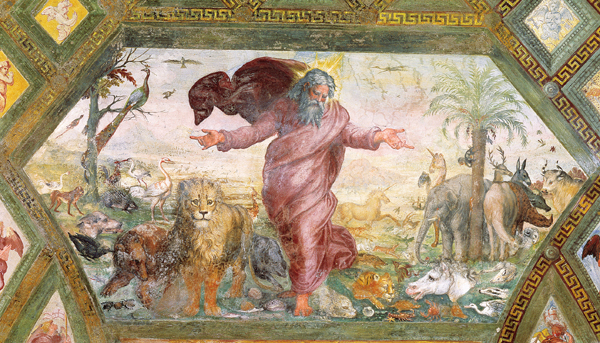
This, then, is the Creation according to God, the Creator. It concludes with the summary statement of Genesis 2:4a: “These are the generations of the heaven and of the earth when they were created.”
Man’s very different perspective on Creation immediately follows. It begins in the second half of Genesis 2:4 with the words “In the day that the Lord God (YHWH Elohim) made earth and heaven…the Lord God formed man from the dust of the earth” (Genesis 2:4b, 7). Man is God’s final creation in Genesis 1; here he is first. The orderly progression of God’s account—in which the less highly evolved species precede the more highly evolved animals, and where sea creatures precede the beasts that dwell on land—has been abandoned. Pride of place is given to man, while the Creator is criticized. In man’s view, he was formed first and, due to the Lord God’s error, alone.
Man’s perspective is initially revealed in the very first verse of his account, when the Lord God “makes” earth and heaven. The Hebrew verb
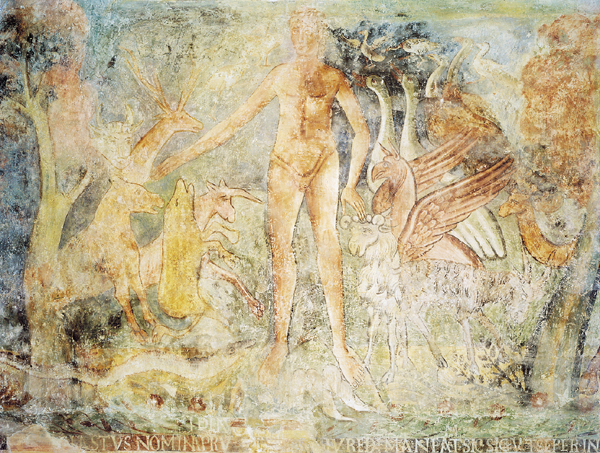
And what, according to man’s perspective in Genesis 2, does the Lord God make? “Earth and heaven.” This phrase, too, signals a shift in point of view. The phrase “heaven(s) and earth” occurs three times in God’s account (Genesis 1:1, 2:1, 2:4a), and each time the word “heaven(s)” precedes “earth.” In Genesis 2:4b, however, “earth” is given priority. Man is more concerned with his own dwelling place than with the cosmos. His version of the story is literally “down to earth”; it excludes the celestial. Genesis 2:4b–4:26 offers a homespun etiology of earthly matters describing how the animals got their names, how death and evil entered a “very good” world, why man has to labor for a living, why woman has to labor in childbirth, why the snake has no legs and so on.
The optimism of God’s account is missing. Instead, from the very start of man’s version we find negativity, a focus on what does not yet exist: at the time of man’s creation, “no plant of the field was yet in the earth and no herb of the field had yet sprung up—for the Lord God had not caused it to rain upon the earth, and there was no one to till the ground” (Genesis 2:4b–5). In his overweening self-importance, man sees himself as essential to the Lord God: he is required to till the earth. Man, however, seems hardly to need the Lord God. For even though the Lord God has not yet created rain, Eden is nevertheless well watered: “A stream would rise from the earth”—seemingly without any help from God—“and water the whole face of the ground” (Genesis 2:6). Man need not depend upon the Lord God for rain.
Man’s materialism and acquisitiveness are highlighted in Genesis 2:11–12, where we learn that there is gold in the “land of Havilah” and that “the gold of that land is good.” The only things seen as “good” in man’s version of Creation are food (Genesis 2:9) and gold—more specifically, gold found in a land not his own. If the reader had been unsure about whose viewpoint dominates the second Creation narrative, the uncertainty is now dispelled. In whose value system is gold good? Certainly not in God’s. After all, what would God buy with gold? And from whom? Man is a corporeal being and must eat, and so his positive assessment of food is natural and predictable. But his estimation of foreign gold bodes ill for the future peace of humanity.
All direct speech in the Hebrew Bible is revealing, and a character’s first address bears extra freight. It is significant, therefore, that God’s first speeches to man, in Genesis 1, convey a blessing and a gift, whereas in the second Creation narrative, the Lord God’s first words are an order: “And the Lord God commanded the man, ‘You may freely eat of every tree of the garden; but of the tree of the knowledge of good and evil you shall not eat, for in the day that you eat of it you shall die’” (Genesis 2:16–17). The inclusive dietary “all” of Genesis 1:29 (“I have given you every plant-yielding seed that is upon the face of all the earth, and every tree with seed in its fruit”) remains, but it is immediately qualified by a stern threat. Benevolence has become oppression. God sees himself as a source of blessing and abundance; man sees God as a fearsome dictator who deals in death.
The Lord God’s next utterance to man in the second Creation account concerns something that is “not good”: “It is not good that the man should be alone” (Genesis 2:18). The universal goodness of the first chapter has disappeared. In this version of events, man perceives a deficit: the Lord God’s earth is not complete and sufficient, for man is a social being and needs a mate.
According to this second Creation account, the Lord God forms all the animals species by species and trots them out before the man to be named. Man competently names the beasts, although the Lord God, from the human point of view, fails again and again to provide a suitable mate: “The man gave names to all cattle, and to the birds of the air, and to every animal of the field; but for the man there was not found a helper as his counterpart” (Genesis 2:20). Unsuccessful with countless candidates, the Lord God finally builds a woman from man’s rib. Man loves himself so much, the author amusingly implies, that he cannot help but be charmed by bone of his bone and flesh of his flesh. So moved is the first man in the world that he utters his first words (I translate literally): “This time! Bone of my bone and flesh of my flesh. This will be called woman, because from man she was taken, this” (Genesis 2:23).
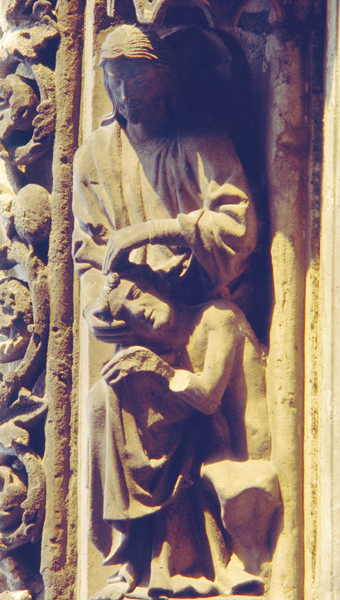
Man does accept the Lord God’s handiwork as his mate—but not with open arms. “This time!” he exclaims, as if to state condescendingly, “Finally, Lord God, you got it right!” After taking this poke at the deity, man assigns the generic name “woman” to this new creature. Although he acknowledges that this one is of the same substance as he, man nevertheless seems to regard her with disdain. Man identifies her by using the demonstrative pronoun “this.” Most translations leave out one or two of the demonstrative pronouns and obscure the supercilious articulation with the warmer, more polite word “she.” The author, however, intends to emphasize man’s patronizing attitude toward woman, this second comer, by the repeated use of the disparaging pronoun that is frequently used in the Hebrew Bible to distance and malign.b With the insistent repetition of the alienating pronoun, we see that man endorses woman, but only at arm’s length. In the Hebrew original, the denigrating “this” is the first, the last and precisely the middle word of his speech. Given the repetition and careful placement of the pronoun, it is difficult to imagine that its chilling effect was not calculated.
The literary styles of the two Creation accounts also differ markedly. In Genesis 1, God moves in stately periods to create a world. Like the procession and recession of waves pounding against the shore, the echoing phrases of chapter one separate the acts of creation and establish a rhythm. Each “and God said” draws us up to a new creative act; each recurring phrase—“and it was so,” “and God saw that it was good,” “and there was evening and there was morning”—recedes from it. The ebb and flow of the narrative confer a decorous, unhurried and deliberate ceremoniousness. The construction job of creation is not messy; it is orderly. But the metrical resonance and cyclic intervals with which the narrator renders God’s activity in the first Creation account end at Genesis 2:4b, where the narrator commences man’s mundane and somewhat discontinuous version of events (for example, the Lord God places man in the garden in Genesis 2:8 and again in Genesis 2:15).
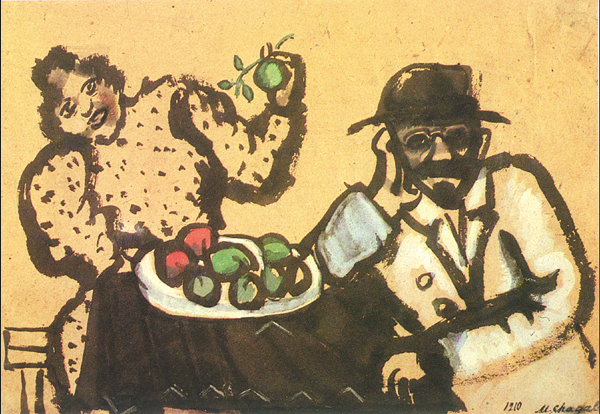
The dramatic stylistic divergence of the two chapters does not escape the discriminating eyes of the source critics who conclude that the change in style reflects a change in authorship. I suggest, however, that the author of Genesis, like film director Kurosawa, deliberately varies his narrative style in order to illustrate the capabilities and limitations of different characters. God’s expression is august; man’s is ordinary.
An even more striking difference between the two versions of the Creation story—and the one that has so exercised the source critics—is the deity’s name change from the generic term “Elohim” in Genesis 1 to the sacred, personal “YHWH Elohim” (Lord of God) of Genesis 2. To source critics, the shift can only makes perfect literary sense: the name of the deity changes in chapter two because here God is no longer depicted as the transcedent Creator of everything and every person, pagan and Israelite alike. Rather, he is shown by the use of his intimate name to be in an immanent relationship with the man who will be the ancestor of all humanity.
Source critics who posit different authors for the two Creation accounts detract from the richness and wit of the narrative. The narrow and negative nature of man’s worldview becomes apparent only when we are first given a broader and more approving view of the universe. By considering teh disagreements and comparing the distinct viewpoints presented in each chapter, readers of Genesis gain their initial insight into the author’s assessment of both God and humanity. The variations between the first two biblical chapters do not disclose two authors but distinguish two characters, God and man, and reveal the characteristic attributes of each-God’s might, optimism and magnanimity; man’s pessimism, misogyny and greed.
As Kurosawa’s Rashomon reminds us, it is not necessary to stipulate separate authors in order to explain deviations, contradictions or repetitions within a narrative. An author can speak in many voices, vary vocabulary, tell essentially the same story from conflicting points of view and keep his audience engaged for millennia.
To the film experts who credit Kurosawa with inventing a new narrative approach that demonstrates the relativity of perspective, I can only say, “What has been is what will be, and what has been done is what will be done, and there is no new thing under the sun” (Ecclesiastes 1:9).
MLA Citation
Footnotes
See Victor Hurowitz, “P—Understanding the Priestly Source,” BR 13:03.
To give but two examples: In an effort to minimize the difference between his two daughters, Laban, speaking to the deceived Jacob, diminishes both Leah and Rachel by referring to them only as “this.” “Fulfill the week of this, and we will give you this also” (Genesis 29:27; emphasis added). Pharaoh’s servants, referring contemptuously to Moses, ask Pharaoh, “How long will this be a snare to us?” (Exodus 10:7).
Endnotes
Tadao Sato, “Rashomon,” in Donald Richie, ed., Focus on Rashomon (Englewood Cliffs, NJ: Prentice-Hall, 1972), p. 96.
I do not agree with traditional interpreters of the Creation accounts, although they also defend the single authorship of Genesis. Traditionalists, who believe the Bible is the inspired word of God, interpret the second Creation story as an expansion and clarification of the first. They assert that Genesis 1 provides the general outline of the Creation and Genesis 2 supplies the specifics. This interpretation, however, does not explain the inconsistencies between the two accounts. For example, man is clearly the last creature made in the first account, but in the second he is formed before the other animals. Nor does the traditional explanation elucidate the change in style from the majestic, balanced cadences of Genesis 1 to the pedestrian, even choppy, asymmetrical structure of Genesis 2.

